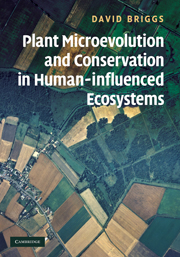Book contents
- Frontmatter
- Contents
- Preface
- Acknowledgements
- List of abbreviations
- 1 Introduction
- 2 Studying change
- 3 Key concepts in plant evolution
- 4 The origin and extent of human-influenced ecosystems
- 5 Consequences of human influences on the biosphere
- 6 Categories
- 7 Investigating microevolution in plants in anthropogenic ecosystems
- 8 Plant microevolution in managed grassland ecosystems
- 9 Harvesting crops: arable and forestry
- 10 Pollution and microevolutionary change
- 11 Introduced plants
- 12 Endangered species: investigating the extinction process at the population level
- 13 Hybridisation and speciation in anthropogenically influenced ecosystems
- 14 Ex situ conservation
- 15 In situ conservation: within and outside reserves
- 16 Creative conservation through restoration and reintroduction
- 17 Reserves in the landscape
- 18 Climate change
- 19 Microevolution and climate change
- 20 The implications of climate change for the theory and practice of conservation
- 21 Overview
- References
- Index
16 - Creative conservation through restoration and reintroduction
Published online by Cambridge University Press: 05 June 2012
- Frontmatter
- Contents
- Preface
- Acknowledgements
- List of abbreviations
- 1 Introduction
- 2 Studying change
- 3 Key concepts in plant evolution
- 4 The origin and extent of human-influenced ecosystems
- 5 Consequences of human influences on the biosphere
- 6 Categories
- 7 Investigating microevolution in plants in anthropogenic ecosystems
- 8 Plant microevolution in managed grassland ecosystems
- 9 Harvesting crops: arable and forestry
- 10 Pollution and microevolutionary change
- 11 Introduced plants
- 12 Endangered species: investigating the extinction process at the population level
- 13 Hybridisation and speciation in anthropogenically influenced ecosystems
- 14 Ex situ conservation
- 15 In situ conservation: within and outside reserves
- 16 Creative conservation through restoration and reintroduction
- 17 Reserves in the landscape
- 18 Climate change
- 19 Microevolution and climate change
- 20 The implications of climate change for the theory and practice of conservation
- 21 Overview
- References
- Index
Summary
This chapter considers the microevolutionary implications of creative conservation, which involves habitat restoration and species reintroduction. It considers underlying concepts and practice, including which stocks to use in projects.
Bradshaw (1987) has devised a general model of ecosystem restoration (Fig. 16.1) to take account not only of the aims of conservationists in parks and reserves, but also the schemes of a wide range of professionals, including landscape architects and landscape gardeners, who have undertaken projects for government departments, local authorities, industrial corporations and private landowners etc. Not all these restorations aim to promote wildlife conservation, although they may do so indirectly. Some are/were concerned with restoring damaged areas to productive farmland, removing pollutants from rivers and lakes, restoring watersheds to prevent erosion etc. (Bradshaw & Chadwick, 1980; Jordan, Gilpin & Aber, 1987; Falk, Palmer & Zedler, 2006). Restoration for nature conservation is, therefore, only one strand in the complex relationship of humans to their landscape.
Restoration presents the ecologists with powerful challenges, providing the ‘acid test’ of the ecologist's understanding of vegetation (Bradshaw, 1987). Harper (1987) likens ecological restoration to the repair of a watch: taking it to pieces provides an understanding of how it works and how it might be rebuilt.
Turning to the details of the model, the diagram indicates how human activities have changed natural habitats. Sometimes ecosystems have been severely degraded, and such areas may be rehabilitated towards their original state by natural plant succession.
- Type
- Chapter
- Information
- Publisher: Cambridge University PressPrint publication year: 2009

